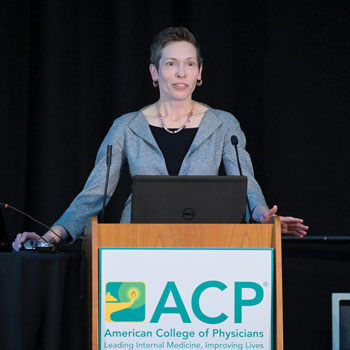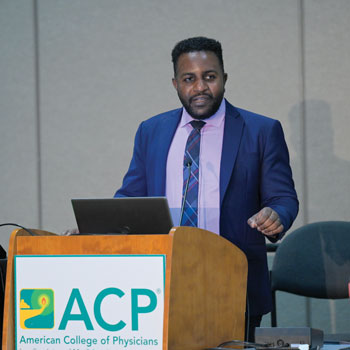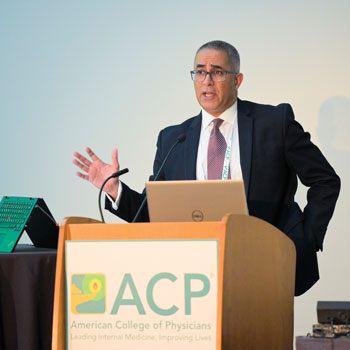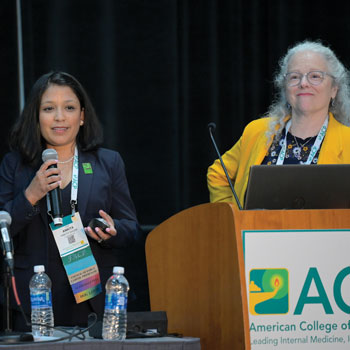Balancing benefits and harms of pain meds in older adults
Pain guidelines issued by medical societies call for nondrug therapies and exercise as primary recommendations for chronic pain.
Before prescribing chronic pain therapies for older patients, Erin E. Krebs, MD, MPH, FACP, first conducts a careful evaluation and considers the big picture.
“Yes, chronic pain is extremely common,” said Dr. Krebs, chief of general internal medicine at the Minneapolis VA Health Care System and a professor of medicine at the University of Minnesota Medical School. “For many, pain is a manageable symptom. For some, pain is a debilitating disease. And for a lot of people, it's somewhere in between. So it is important to figure out where your patient is.”

She emphasized that most meds have harms, so physicians should be carefully considering balance of benefits/harms, actively reevaluating meds, and adjusting according to response.
Pain guidelines issued by medical societies call for nondrug therapies and exercise as primary recommendations for chronic pain, Dr. Krebs said during her talk “My Older Patient Is in Pain: What Is Safe to Prescribe?” at Internal Medicine Meeting 2023 in San Diego. Back pain and osteoarthritis are most common chronic pain conditions in older adults.
“No one therapy works for most people, and the comparative evidence is limited. However, across the board [with nondrug therapies], adverse effects are minimal,” she said. “If anything, active approaches like exercise have positive side effects, such as improving control of hypertension, prevention of cardiovascular disease and metabolic conditions, and prevention of geriatric syndromes, and those positive side effects increase with greater engagement.”
Supporting evidence for medications is also imperfect, said Dr. Krebs. Although evidence is limited and benefits modest across all chronic pain treatments, nondrug therapies are safe whereas meds are often harmful. As with nondrug therapies, medications have modest benefits for chronic pain. In contrast to nondrug therapies, harms of medications can be substantial and often increase with the dose and duration of therapy.
“I would say that how we prescribe may be more important than what we prescribe,” Dr. Krebs said. “It is very important that we think carefully about what we start and that we reevaluate our medication treatment as we go.”
In rough order from least harmful to most harmful, Dr. Krebs outlined drug therapies for chronic pain.
Least risk
Topical analgesics are first for safety. Although the risk of harm is low with capsaicin, its benefits are small for knee osteoarthritis, and it's not effective for peripheral neuropathy. Capsaicin works best for small joints, is not suitable for all locations on the body, and must be applied frequently.
Dr. Krebs tells patients that they will need to keep applying capsaicin at least every six to eight hours, adding that the side effects are minor: “You're not going to get anything but burning or redness.”
Similarly, lidocaine and topical salicylates have little evidence of effectiveness, but they are very safe. When advising on use of lidocaine patches, Dr. Krebs tells patients to take 12-hour breaks to avoid tachyphylaxis.
“Many of my older patients have felt that they are getting benefit from these drugs and like them,” she said. “I frankly think there's very little downside to trying these for a lot of patients.”
Next up on the scale from safest to riskiest is acetaminophen, which Dr. Krebs called “a bit of a conundrum for me.” The evidence for its effectiveness is poor, but it's considered generally safe at the recommended daily dose for most people, including older adults, with the caveat that its common presence in combination products increases the risk of overdose toxicity.
More risk
NSAIDs carry clear evidence of small to moderate benefits for low back pain, osteoarthritis, and inflammatory arthritis. “The good news is that all NSAIDs seem to have similar efficacy, including the topical ones,” Dr. Krebs said. “But of course, everybody knows oral NSAIDs have important gastrointestinal, renal, [and] cardiovascular risks, especially for older adults, and especially for those with other medical conditions.”
Topical NSAIDs have low systemic absorption and are fairly low risk for most people. Dr. Krebs advised they are worth considering, maybe more than physicians have in the past, especially as they become more available.
She next discussed antidepressants and anticonvulsants as a group because they have similar indications and similar adverse effects. Duloxetine is recommended for back pain in ACP's guidelines and osteoarthritis guidelines from the American College of Rheumatology/Arthritis Foundation, with evidence of small benefits for back pain, arthritis, peripheral neuropathy, and fibromyalgia. But the drug class poses important psychomotor and cognitive risks in older adults.
“[I]f you're thinking about these drugs, shared decision making is important to talk about risks and benefits,” she said. “You really want to see benefits to continue with these. They should not just be continued forever. I think these are some of the most overused medications we have, primarily because they get started and not stopped.”
Most risk
Next, tramadol got its own slot, between antidepressants and opioids, because it has mixed mechanisms of serotonin and norepinephrine reuptake inhibition and opioid agonism. Evidence for tramadol's effectiveness on low back pain, osteoarthritis, and fibromyalgia is better than that for some other antidepressants and opioids, Dr. Krebs said, but it can also have psychomotor and cognitive effects in older adults. Clinicians should assume the risks of dependence, addiction, and overdose seen with opioids apply to tramadol as well, she said.
“I am not a big fan of tramadol,” Dr. Krebs said, calling the drug “the worst of both worlds.”
Opioids took the last spot on the list, as they are the least safe and not recommended by guidelines, although they do have small benefits in terms of pain compared to placebo. Trials generally exaggerate the benefits of opioids, Dr. Krebs said, and tolerance develops very rapidly, quickly counteracting analgesic benefits.
In terms of harms, opioids carry important psychiatric, psychomotor, and cognitive risks, she reminded attendees. Older adults, of course, incur an increased risk of falls. An underdiscussed issue is the risk of physiologic dependence, not just the development of tolerance, but development of adaptations that cause a patient's pain response to be upregulated.
“So they may be helpful in the short term, but they are unlikely to really have efficacy that persists over time in chronic pain, and what we care about in chronic pain is the long term,” she said.
To prescribe safely for chronic pain, Dr. Krebs advised the audience to regularly reevaluate medications and remember, “active self-management and nondrug therapies are the foundation of chronic pain management.”





